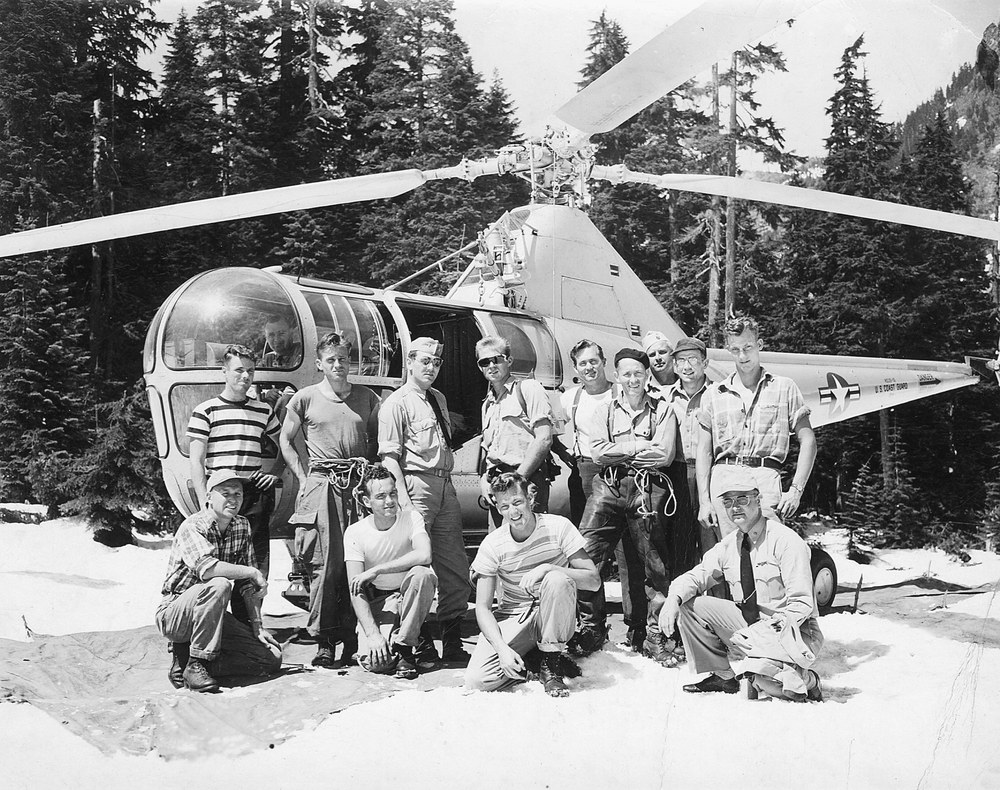
Exposing ourselves to the most unforgiving elements of nature can be cathartic, electrifying – and dangerous. Uncertainty is a necessary part of her appeal, but when Mother Nature (or plain bad luck) starts baring her teeth, today we have measures in place to help you get home safely.
‘Mountain rescue’ is a holy term to many, and for good reason; these volunteer-driven teams are made of dedicated outdoors people from all walks of life who give their time and money to provide a support system to mountain travelers. As Mountaineers, we’re proud to have played a part in the establishment of mountain rescue as we know it today, and indebted to those who have placed themselves at risk for the lives of others.
The origins of mountain rescue
In the early days of climbing, you couldn’t count on being rescued. The more skill required to place yourself in treacherous alpine areas, the less likely you were to be rescued by the Forest Service if a storm blew in. This was the brutal reality of early mountaineering.
However, by the mid-1930s things were changing. With more skilled climbers than ever before, the climbing community sought to advance climbing and protect those who took their chances in the mountains. In this rapidly evolving environment, the death of a young climber served as a catalyst for the creation of early mountain rescue.
In January of 1936, Delmar Fadden set out to climb Mt. Rainier via the Emmons Glacier. He never returned home. His disappearance sparked a rescue effort that culminated in an airborne search, a Mountaineers team facing sub-zero weather and frostbite on the mountain, and ample press coverage. Delmar was eventually found frozen with a roll of exposed film in his pocket, capturing the crater of Mt. Rainier. He had accomplished the first winter ascent of the Emmons route, but perished on his descent.
Following the recovery of his body, the rescue team (led by Omi Daiber, often called the “Father of Mountain Rescue”, whose resume includes the first ascent of Mt. Rainier’s Liberty Ridge) continued their unofficial efforts in the mountains until 1939, when The Mountaineers formed the Mountaineer Rescue Council. This Council offered members a list of rescue volunteers to call when needed, working with the Forest Service and local law enforcement to get injured climbers to medical services safely.
This formula proved successful for a time. Then, following a trip home to Bavaria in the aftermath of WWII, Mountaineer Wolf Bauer was captivated by a film on the mountain guards
on the German-Austrian border. He brought a copy home for his fellow Mountaineers, and it became apparent that the techniques being used in the Pacific Northwest needed an update. Thus the Mountain Rescue Council was established in 1948, coordinated in partnership with the Washington Alpine Club, the northwest region of the National Ski Patrol, and The Mountaineers.
A flurry of conferences and budding interagency relationships led quickly to technological development in rescue communications and mountain stretchers. Branches of the Washington-based Mountain Recue Council grew and, in 1959, the National Mountain Rescue Association was formed with teams in Alaska, Idaho, Montana, Colorado, Arizona, California, and New Mexico.
Delmar’s death was tragic, but served as the spark for a series of events that created the mountain rescue teams we know and rely on today. Over 80 years have passed since the original rescue team faced mountain storms and frostbite to search for the young climber, and it’s because of them that we know exactly who to call when nature’s growl grows to a roar. Their legacy of dedication and skill helped lay the foundation for decades of mountain rescues and countless saved lives. And we remain indebted to the many individuals who continue to train and deploy for our collective mountain safety today.
Lead Image of members of the Mountain Rescue and Safety Council and a U.S. Coast Guard helicopter crew conducting a practice rescue in 1949. They include Chuck Welsh (standing far left), Dee Molenaar (next to him), Cornelius “K” Molenaar (fourth from left), Ome Daiber (center with beret), Jim Whittaker (right), and Lou Whittaker (kneeling third from left). Photo from the Dee Molenaar collection.
The information in this story was sourced from The
Mountaineers: A History, by Jim Kjeldsen.
This article originally appeared in our Summer 2020 issue of Mountaineer Magazine. To view the original article in magazine form and read more stories from our publication, visit our magazine archive.
 Hailey Oppelt
Hailey Oppelt